Variegated wax plants, often known as hoya plants, require a special care routine. If you don’t understand the setting and care required for this popular houseplant species, you’ll struggle to grow a healthy one in your home. Fortunately, we’ve created this comprehensive guide to tell you everything you need to know about variegated wax plant care.

Where to Grow a Variegated Wax Plant
Before you start growing a variegated wax plant, sometimes called porcelain flower, you should have a complete understanding of the setting in which this plant thrives. Variegated wax plants come from areas that are naturally hot and have relatively high humidity levels. But as you will soon see, there are several other considerations to make when selecting the perfect location for your variegated wax plant.
Hardiness
Variegated wax plants enjoy a hot climate in their native range and will survive in zones nine through 11. If you live in areas such as southern Florida, Texas, or California, then you have a chance to grow this plant outdoors year-round.
However, anyone who lives in an area colder than zone nine will need to grow this plant indoors. Any time that a variegated wax plant experiences temperatures around 20 degrees Fahrenheit or less, it will begin to decline. Thankfully, these plants can survive well in indoor settings so long as you can provide the correct growing conditions.
Sun Requirements
When growing indoors, variegated wax plants will do best when they receive a bright light that is also indirect. A location near an east-facing window with natural light often proves to be most effective. While these plants do not tolerate heavy shade, prolonged, direct sun exposure is detrimental as well.
If you live in one of the few regions in the United States where this plant can survive outdoors, you should seek to provide a similar type of indirect light. In such settings, you should not allow your variegated wax plant to sit in direct sunlight for no more than a few hours per day.
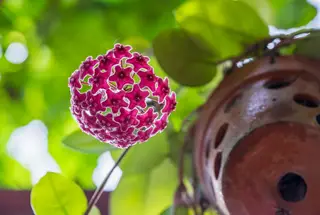
Soil Characteristics
The soil for a variegated wax plant should be somewhat loose to allow excellent drainage. Waterlogged soils and standing water will both have a negative impact on this plant’s health.
The soil for this species should also be somewhat acidic. Typically, a pH that falls below seven but above six will create the ideal environment for the roots of a variegated wax plant.
Umidade
The final factor that helps create the ideal growing setting for a variegated wax plant is humidity. A humidity percentage of around 40 will permit this plant to survive. However, a higher humidity of 60 percent or more will be much better.
Achieving these humid conditions that a variegated wax plant needs can be difficult, especially when growing one indoors. Drafts from air conditioners, heaters, and other machines can cause the air in your home to be too dry. To combat this problem, you can try misting or adding a humidifier to the room in which your variegated wax plant grows.
Our Favorite Variegated Wax Plants
| Imagem | Título | Melhor | Comprar |
|---|---|---|---|
 | (Rare) Hoya Tricolor - 4" from California Tropicals | Melhor | Verifique o preço na Amazon |
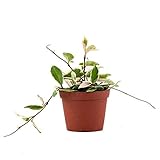 | AMERICAN PLANT EXCHANGE Hoya Carnosa Krimson Queen Live Plant, 6" Pot, Stunning Indoor Air Purifier | MelhorElegível | Verifique o preço na Amazon |
Principal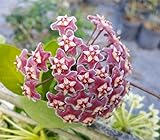 | SmartMe Hoya Pubicalyx Mottled-Silver Leaf Live Plant Wax Plant Tropical Vine 5" Tall | Melhor | Verifique o preço na Amazon |
 | American Plant Exchange Hoya Carnosa Assorted Wax Live Plant, 6" Pot, Easy Care Colorful Cascading Vines | MelhorElegível | Verifique o preço na Amazon |
 | Hoya Carnosa - 6" from California Tropicals | Melhor | Verifique o preço na Amazon |
 | Rare Pubicalyx Wax Plant - Hoya - Great House Plant - 6" Hanging Basket | Melhor | Verifique o preço na Amazon |
 | Tricolor Hoya Carnosa Krimson Queen Variegated in 4" Pot ,Hoya Carnosa Variegatedin 4 inch Pot, Limited Quantity by 3exoticgreen | Melhor | Verifique o preço na Amazon |
How to Care for a Variegated Wax Plant
Knowing the best growing conditions for a variegated wax plant is not enough to grow one successfully. If you want your plant to be as saudável e bonito as possible, then you need to create a comprehensive hoya plant care routine as well. The following sections will show you how.
Rega
Although variegated wax plants love to live where the air has plenty of moisture, they don’t enjoy it when they grow in soggy soil. In fact, your main goal in watering this plant should be to avoid overwatering. Anytime you give your variegated wax plant too much water, you risk giving it root rot. To avoid this problem, you need to understand how this plant grows throughout the entire year.
During the spring and summer months, variegated wax plants exhibit their most vigorous growth and need more supplemental water than during other seasons. During spring and summer, consider giving this plant water about once per week. However, you may need to alter that schedule to prevent the soil from holding excess water.
Sometimes, it is best to water your variegated wax plant by monitoring the overall dryness of the soil. Usually, you should wait until at least the first few inches of soil are dry before you add more water. Again, soil drainage is crucial here as it prevents too much standing water. You can also water based on how the leaves look by waiting until the foliage is slightly wrinkled before giving more water.
During the winter months, the growth of a variegated wax plant will be much slower, meaning that it will need far less water. During this season, reduce your watering to about once per month or less if needed. Always remember that overwatering is far more likely to kill this plant than a lack of water.
Fertilizante
Fertilization for a variegated wax plant also depends on the time of year. During the growing season, when the plant is not in bloom, it can help to provide a nitrogen-rich fertilizer, as nitrogen will promote healthy foliage.
However, just before and during the bloom period, which occurs during spring and summer, give your variegated wax plant a fertilizer that has more phosphorus. While nitrogen is best for foliage development, phosphorus supports healthy flowering. During the bloom time, your plant may need a higher amount of fertilization as it uses more energy overall to produce its fragrant flowers.
During the winter, you can drastically reduce your fertilization frequency, and in many cases, you may not need to fertilize at all. For the rest of the season, applying a liquid fertilizer about twice per month will lead to the best results.
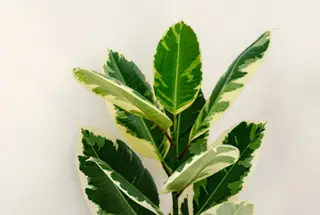
Pruning a Variegated Wax Plant
Pruning is another essential gardening task when growing a variegated wax plant. You can prune to improve both the health and the appearance of this plant, but there are a few insights that you should understand before you do so.
Perform your pruning in the spring and summer when the plant is growing the most, as this will allow it to recover quickly from your pruning cuts. You should also be wary of removing spent hoya flowers from this plant. While many flowering plants respond well to deadheading, variegated wax plants hold their next set of flower buds on the spurs left from old flowers.
Allow spent blooms to remain on the plant as this will promote future blooms. Focus instead on removing vegetation that shows damage, disease, or weak growth characteristics. When you identify a part of the plant you wish to remove, find a node, a slight bulge where a leaf stem meets a main vine, and make your cut there.
While variegated wax plants often do well with seasonal pruning, you should be careful not to take away too much of the plant’s foliage. In general, you should avoid taking off more than one-third of the plant’s total mass when you prune.
LEITURA ADICIONAL
- How to Plant (and Care For) Japanese Iris
- Escolhendo as plantas certas para jardinagem em contêineres
- Como plantar bulbos de orelha de elefante em vasos
- Explorando as muitas faces das plantas Euonymus
Problems to Lookout for When Caring for a Variegated Wax Plant
You now know some of the basics of caring for a variegated wax plant. However, if you want yours to be in the best condition, you need to know about some of the most common problems when growing this plant. Here are a few of the most prevalent issues that gardeners face when maintaining a variegated wax plant:
- Muita água: Giving your variegated wax plant too much water often leads to root rot. Always ere on the side of giving your plant too little water rather than too much.
- Poor soil drainage: Even if you give the proper amount of water to your variegated wax plant, poor soil drainage can cause root rot to occur anyway. Make sure that the soil mix you use has good drainage. If you use a container, make sure that it has an efficient drainage hole or some other way to allow water to filter out of the soil.
- Too much fertilization: While fertilization is beneficial, it can cause problems if you do too much. Excessive fertilization can lead to fertilizer burn, which usually causes visible symptoms such as discolored leaves.
- Dry air: Variegated wax plants love a humid environment, and most indoor rooms do not provide enough. Make sure the area in which your plant grows has enough air moisture to keep it happy and healthy.
- Insect infestation: Insect infestations can occur with variegated wax plants as well. ácaros, aphids, scale bugs, and others can all affect this plant species. But in most cases, treatment of insecticidal soap should act as an effective remedy.
- Diseases and infections: Variegated wax plants can encounter problems with fungal and bacterial infections. Among those complications, root rot and botrytis blight are the most pervasive. However, sooty mold and other afflictions can occur as well. These problems often cause gray or brown leaf spots and require fungicide for effective treatment.
- Poor lighting: Both too much and too little light will cause your variegated wax plant to fail. Be sure that yours grows where there is bright indirect light. Move your plant as needed until you find the ideal light setting.
While each of these problems can be frustrating, you should be aware of them before you begin growing a variegated wax plant. Knowing about these common issues will help you anticipate and treat them correctly if they arise.
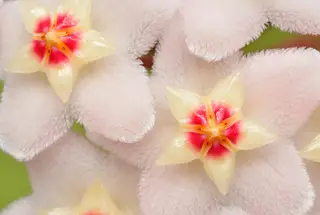
FAQs about Variegated Wax Plant Care
A lot of gardeners come up with several questions about variegated wax plants. In response, we’d like to supply a few brief answers to the most common ones. Read on to learn more about this plant and some of the common inquiries people make about it.
The species of variegated wax plant, known by its botanical name Hoya carnosa variegata, that so many people grow as an ornamental house plant mainly comes from Southeast Asia. In countries such as Thailand, Laos, and Cambodia, you can find these tropical plants growing naturally. This native range extends to southern China, parts of Japan, and a few other neighboring countries as well.
Most variegated wax plants will grow as a trailing or climbing vine. Often, these plants grow in containers, out of which their stems and foliage dangle in the open air. If you provide a structure and train this plant, it is possible for it to climb by entwining itself into that support. Still, the climbing ability of your variegated wax plant depends on the variety you have, as not all will climb to the same degree.
Although they can look quite different than most succulents people grow indoors, variegated wax plants do belong to this group. If you grow one, you’ll notice that this plant has waxy, succulent-like leaves that are quite fleshy, and the shoots have a succulent-like quality as well. As such, this plant is technically a succulent species.
There are several reasons that may explain why your variegated wax plant is not blooming. In many instances, a lack of light exposure is the reason why these plants fail to bloom. Inadequate soil characteristics can be a cause as well. However, some of these plants don’t flower because they are too young. Only after about five or more years will a variegated wax plant reach flowering age.
Variegated wax plants can be incredibly long, especially when they grow in the wild. In the ideal outdoor setting, one of these plants can become around 20 feet long or more. However, when growing in a garden, these plants are often much smaller. A six to seven-foot length will often be the maximum size for a mature plant.
There are several materials that you can use to amend the soil of a variegated wax plant. But if the issue you’re experiencing is a lack of soil acidity, then adding coffee grounds is one of the best approaches you can take. Sprinkling coffee grounds into the soil will help lower the pH, which your variegated wax plant will appreciate.
You can propagate variegated wax plants by removing stem cuttings in the spring or summer. The cutting you take should include one or more green leaves and a relatively long stem. Allow the cutting to sit in water until it develops roots. Then, transfer the cutting to a container with a healthy potting mix.
Final Thoughts on Variegated Wax Plant Care
Growing a variegated wax plant is not too difficult if you know what to do. Follow our advice on the proper care for one of these plants, and soon you’ll have a lovely vine that graces your home with white flowers and foliage that can’t be beaten.

John Haryasz é escritor freelancer e paisagista. No campo da arquitetura paisagística, ele contribuiu para muitos projetos de design bem-sucedidos em todo o país. Como escritor, John se especializou na criação de conteúdo da web cativante e informativo. Por meio desse trabalho, ele pretende compartilhar seu conhecimento de design e promover o envolvimento com o mundo ao ar livre.

![Como regar plantas de interior [Cuidados com as plantas 101]](https://wraxly.com/wp-content/uploads/2021/03/How-to-Water-Indoor-Plants-Plant-Care-101-1200-1024x576.webp)

![Cultivo de plantas a partir de mudas [Um guia simples]](https://wraxly.com/wp-content/uploads/2021/03/Growing-Plants-from-Cuttings-A-Simple-Guide-1200-1024x576.webp)